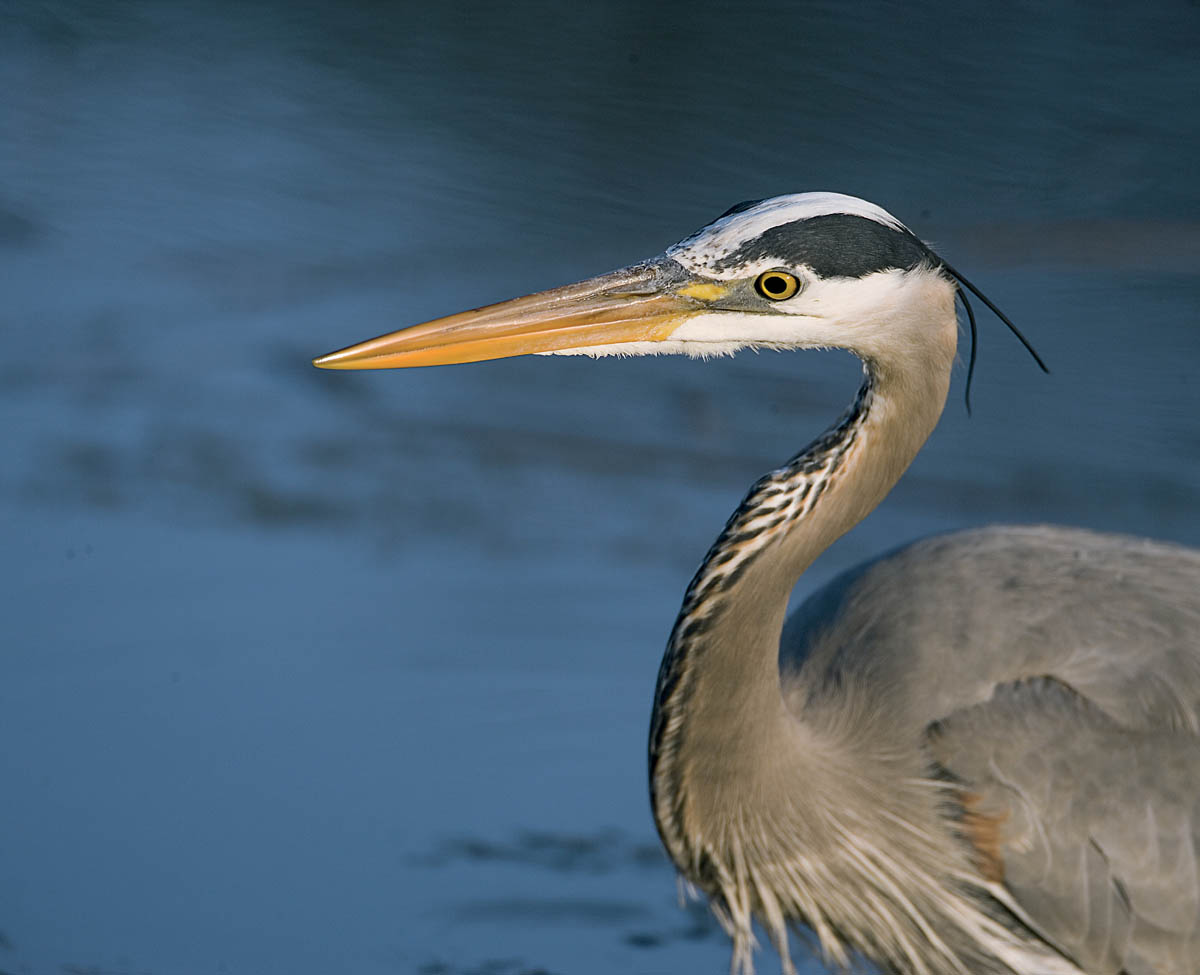
Great Blue Heron adult
Flowers are a traditional, romantic gift for human lovers. Great Blue Herons would be more likely to say it with sticks. The beautiful interplay between the romantic and the practical infuses their entire courtship.

Great Blue Heron adult
Great Blue Herons nest in trees, often at a distance from the best feeding grounds. Their nest must be fairly substantial to provide a safe platform for their eggs and then for the nestlings, which remain in the nest for seven to eight weeks and, as fledglings, return to it for feedings for a few weeks more.
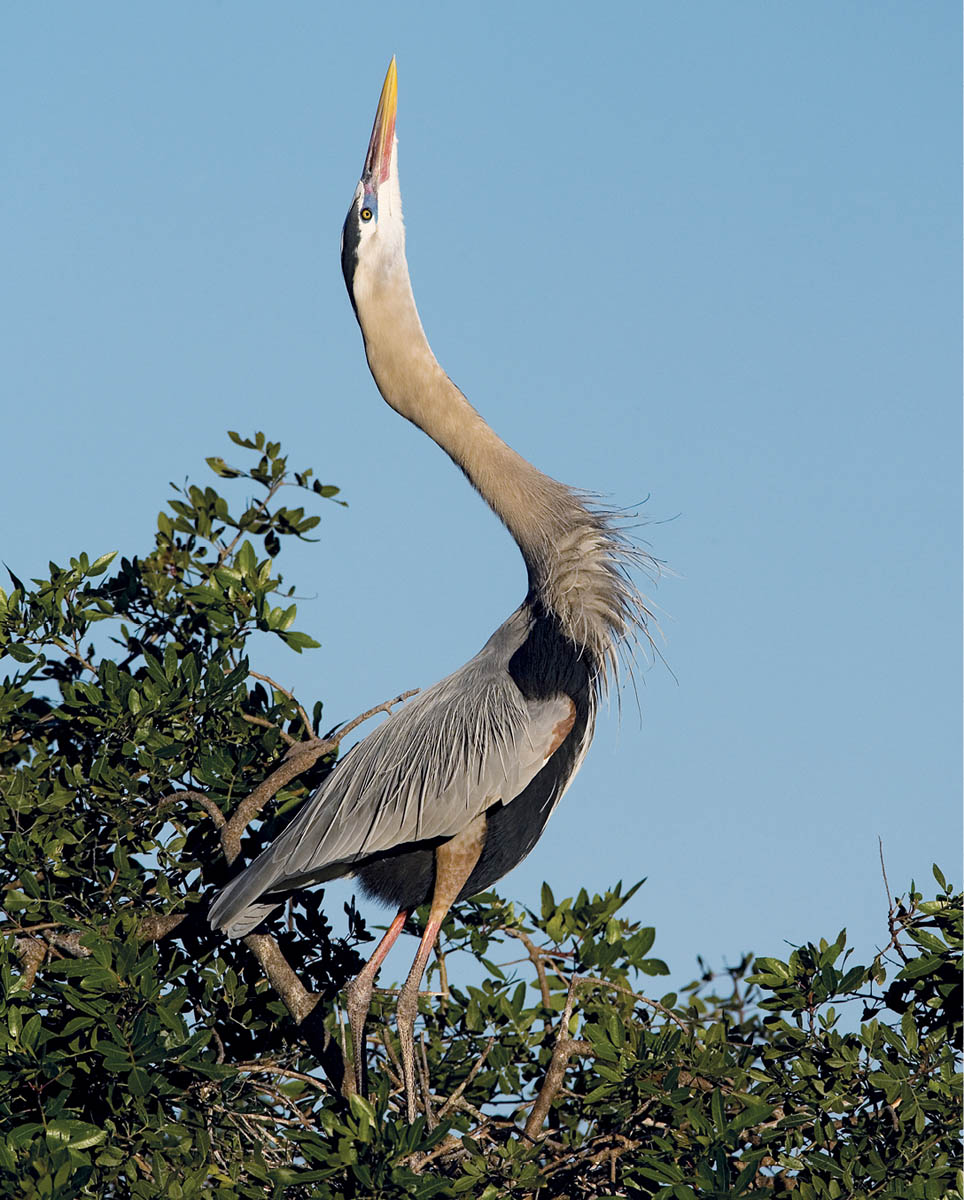
A male performs the stretch display to potential mates passing his nest. Once a pair forms, the bird on the nest performs this display to its approaching mate, but not to other birds.
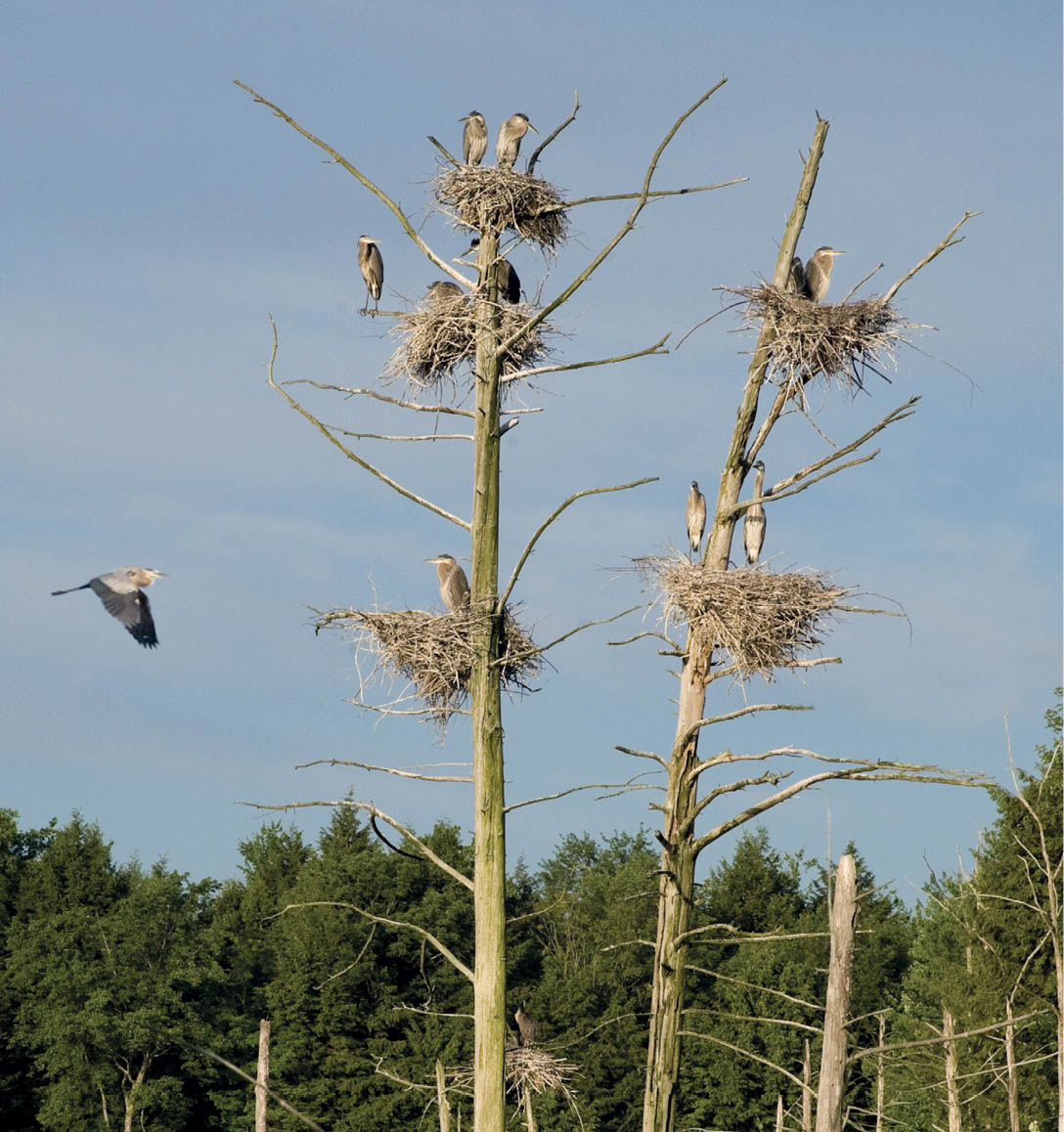
Great Blue Herons often nest in colonies called heronries or, less precisely, rookeries, which may consist of dozens or even hundreds of nests. They usually nest in trees but sometimes nest in bushes and mangroves or on the ground, Osprey nest platforms, channel markers, and other natural and human-made structures.
Herons seem to prefer using nests built in previous years, adding sticks throughout the season. They use large sticks for the actual structure, laying tiny twigs, usually broken off from larger sticks, flat on the floor to close gaps that could entrap an egg or chick.
Both sexes work on the nest, though males bring most of the sticks and females do most of the construction. Several pairs may build nests in the same tree, though they defend the area immediately surrounding their own nests by raising their crests and jabbing at too-close birds with their bills.
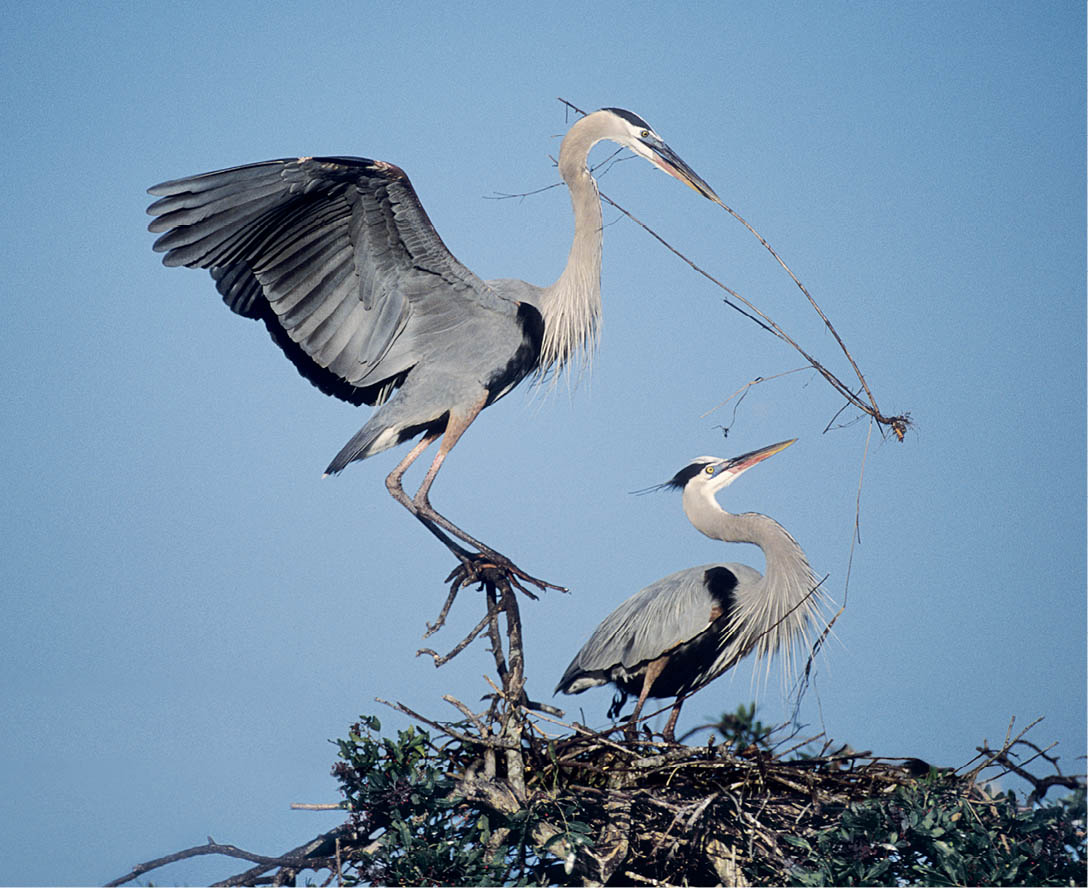
This male Great Blue Heron has just arrived at the nest with a long stick. Now the pair will perform the stick transfer display: as she positions the stick, he claps the tips of his bill together (bill clappering). Sometimes both birds perform bill clappering together.
When a female is on the nest and the male flies in with a stick, she performs a stretch display, accepts the stick, and wedges it into the nest. The pair may also perform other elaborate displays together: raising and lowering specialized feathers called nuptial plumes, stretching necks upward, or clacking bills. These behaviors stimulate the hormonal levels of both birds to trigger ovulation and sperm production and maintain their bond.
The nest is never “finished” and the herons never stop adding on and improving it, but it is ready when the floor is secure enough that eggs won’t fall through or get wedged. That seems to trigger the female’s receptivity to mating.
At that point, she will accept a new stick from the male, add it to the nest, and then crouch, ready to mate. The male climbs on her back, balancing by holding on to her head, neck, or long nuptial plumes at the back of her head. Nearly all mating occurs on the nest after the exchange of one of those all-important sticks.
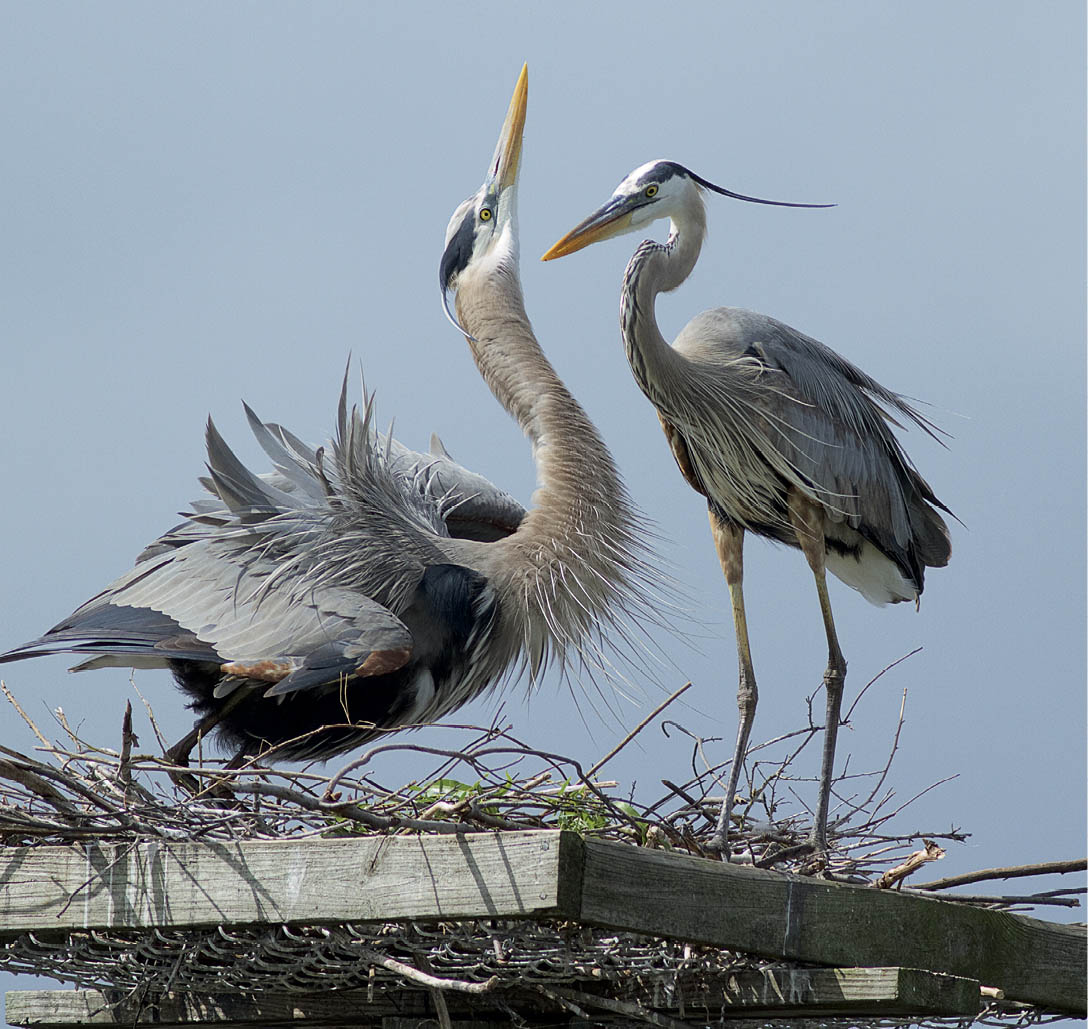
A Great Blue Heron just returned to the nest and the two perform their greeting display. A deep squawk, the landing call, affirms their bond. Conspicuous nesting behaviors announce that this nest is defended territory.
The female seems to struggle during egg-laying, arching her back and shuddering. When the male returns to the nest after she’s laid the egg, he often flies off to bring more sticks. The pair mates frequently during the days around egg-laying. The female lays a new egg about every two days until her clutch of two to six eggs is complete. The parents take turns incubating, each usually on the nest for several hours at a time.
One early spring night a foot of snow fell in the Cornell Lab’s Sapsucker Woods while a male heron was incubating. He remained on the nest all night except for once, when he stood up, shook the snow off his head and back, and peered all around. After seven or so minutes, he sank back down to incubate again. It stopped snowing in the morning, but snow remained in a circle around the eggs most of the day. The male sat steadily without being relieved by the female all day. Finally, in late afternoon, he flew off. People watching him via the Cornell Lab’s online nest cam feared that he was giving up, but less than a minute later he returned, and five minutes or so after that, his mate flew in from the same direction. She took over, he went off to finally have a bite to eat, and all the eggs hatched safely the following week.
In some areas, Great Blue Herons prefer nesting above alligator-infested waters. In the rare case that a chick falls out of the nest, it’ll be eaten, but because adults only feed their chicks inside the nest, any that fall out before they can fly are doomed anyway. Meanwhile, those alligators protect the nest trees and all the chicks from raccoons and other swimming, climbing predators.
Inside an egg, the growing chick’s long bill has forced its head down; the bill’s tip, with its raspy little egg tooth, rests near the bird’s feet. When it’s time to hatch, the chick scrapes the egg tooth against the inner shell until it finally pips, that is, pushes out a little hole in the shell. Calling or clacking its bill, it squirms as it works to expand that pip into a crack encircling one end of the egg.
It may take 24 hours for the crack to go almost all the way around, when the chick can finally push off that end of the shell. The bigger shell fragment may stay on the tiny hatchling’s head for several minutes before it can wriggle out from it. Because of its shape and how it covers the hatchling’s head, some people have nicknamed that piece of shell the “shellmet.” If the chick can’t get it off, a parent will finally pick it off and toss it away.
After hatching, the tiny chick may sleep for a while. A second chick may hatch that same day if the parents delayed incubation until the second egg was laid. Eventually, the parent that has been attending the nest stands in front of the chicks with his or her bill touching the nest floor in front of them. The chicks tap the beak, stimulating the adult to regurgitate a pile of pre-digested fish onto the nest floor.
Unlike most species, adult Great Blue Herons make no effort whatsoever to avoid pooping in their nest. Liquid and acidic, their droppings may serve two useful purposes: gluing nest materials together (especially the twigs forming the floor) and killing harmful bacteria. The parents are not as careless as they appear: they position themselves so they won’t befoul the eggs or chicks.
When Great Blue Herons are catching fish, they swallow them where they catch them. The food goes down the esophagus and enters the proventriculus, the upper chamber of their two-part stomach, where acids and other secretions start digesting the material. (The other chamber is called the gizzard. This muscular stomach helps squeeze the nourishing elements of the food into the intestines. Anything left over is spit up as a pellet; heron digestive juices break down most fish scales and bones.)
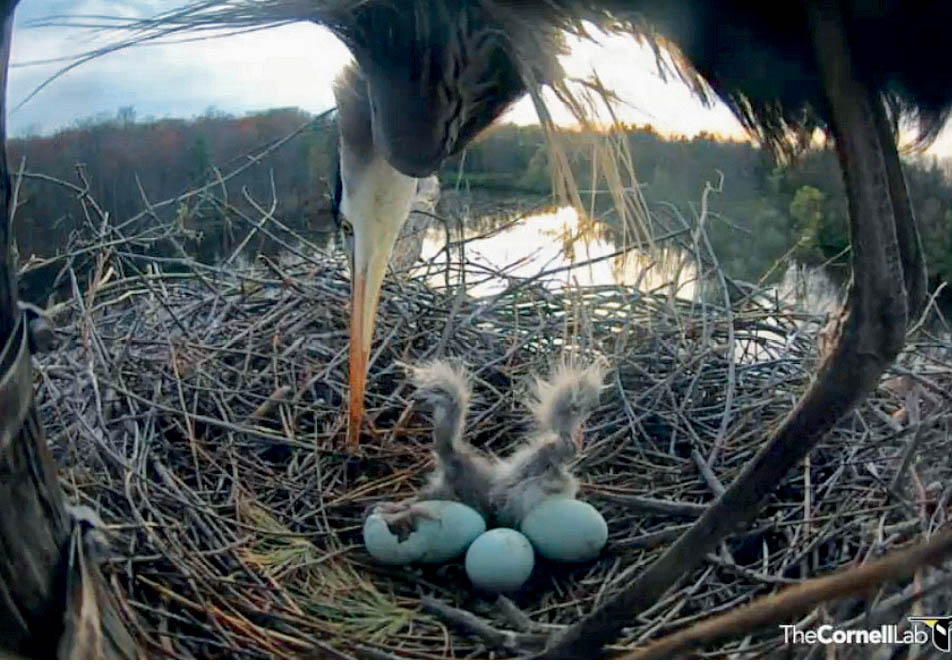
Two of the five eggs in this nest have hatched. A third young heron has pipped its egg and is now working on making a wide crack. When the crack is long enough, the chick can push off the smaller shell fragment with its feet to hatch. The parents feed the tiny chicks small, infrequent meals at this stage of development. Viewers watched this scene live on the Cornell Lab of Ornithology’s website: http://cams.allaboutbirds.org
.While chicks are tiny, the adults may wait a few hours after hunting before feeding them to allow the fish to soften before presenting them to the chicks. As the chicks grow, the parents give them more time to eat and start regurgitating fish that haven’t been softened in their stomachs as long.
In a close study of one nesting pair, the parents nearly always deposited the food closest to the tiniest two chicks in a brood of five. The smallest, which hatched a few days after all the others, grew more slowly than the rest. Even though the largest chicks grabbed food voraciously and got the lion’s share, the smallest became very quick at grabbing what it could. Hunting was good that season, and despite the significant size differences, all five chicks successfully fledged. Some researchers have reported aggression between nest mates, but siblicide is far rarer in Great Blue Herons than in some other herons and egrets.
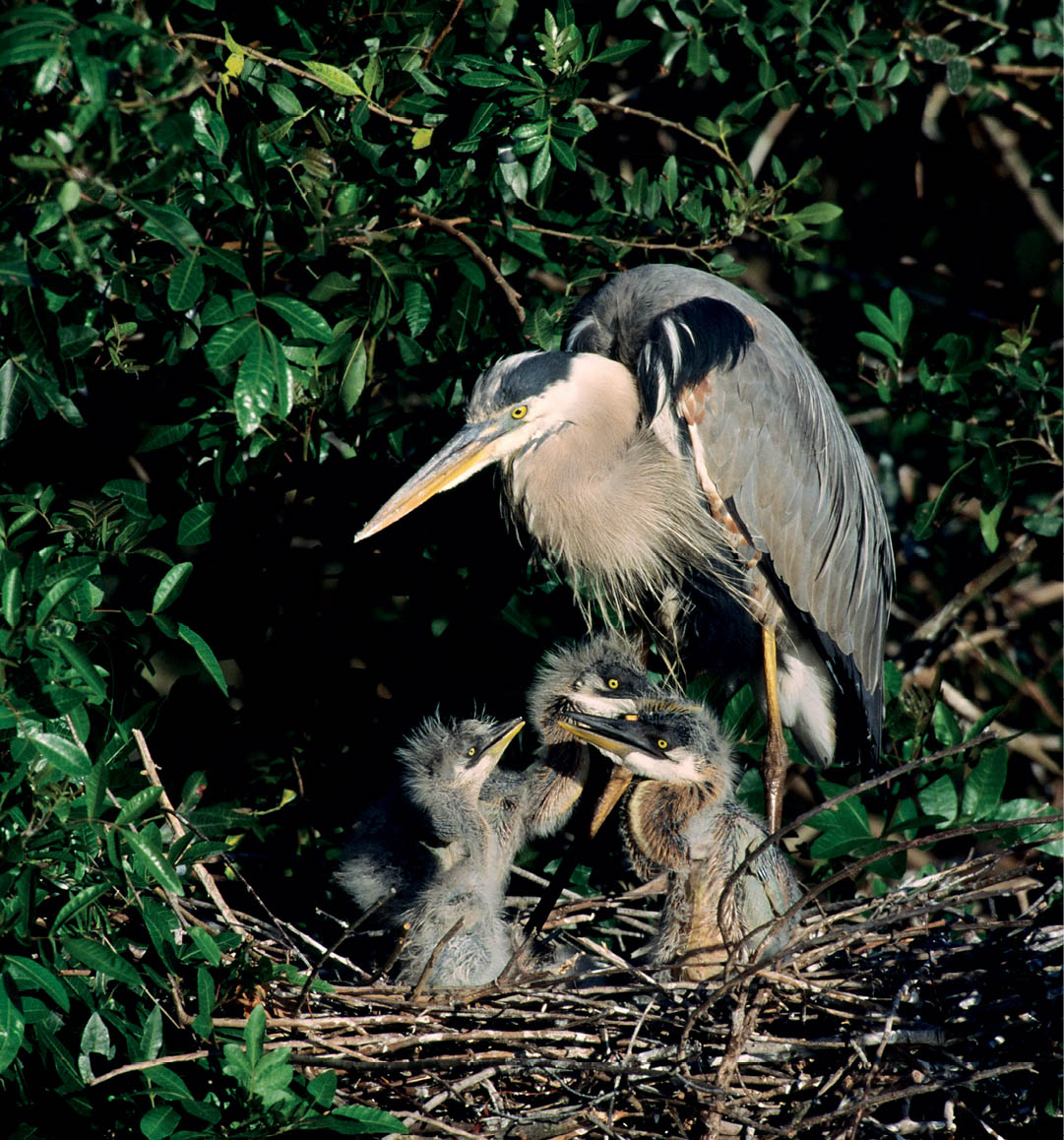
These 2-week-old herons can sit up and look around. They’re starting to pay attention to the world around them. Their plumage is still downy.
By the time the chicks are a month or so old, the parents are regurgitating large, fully intact, almost fresh fish that the chicks swallow whole. Sometimes a long fish will fill a chick’s stomach and esophagus, stretching its neck upright so it looks like a fuzzy bowling pin. After eating their fill, the chicks topple over in what Thanksgiving feasters might call a “food coma.”
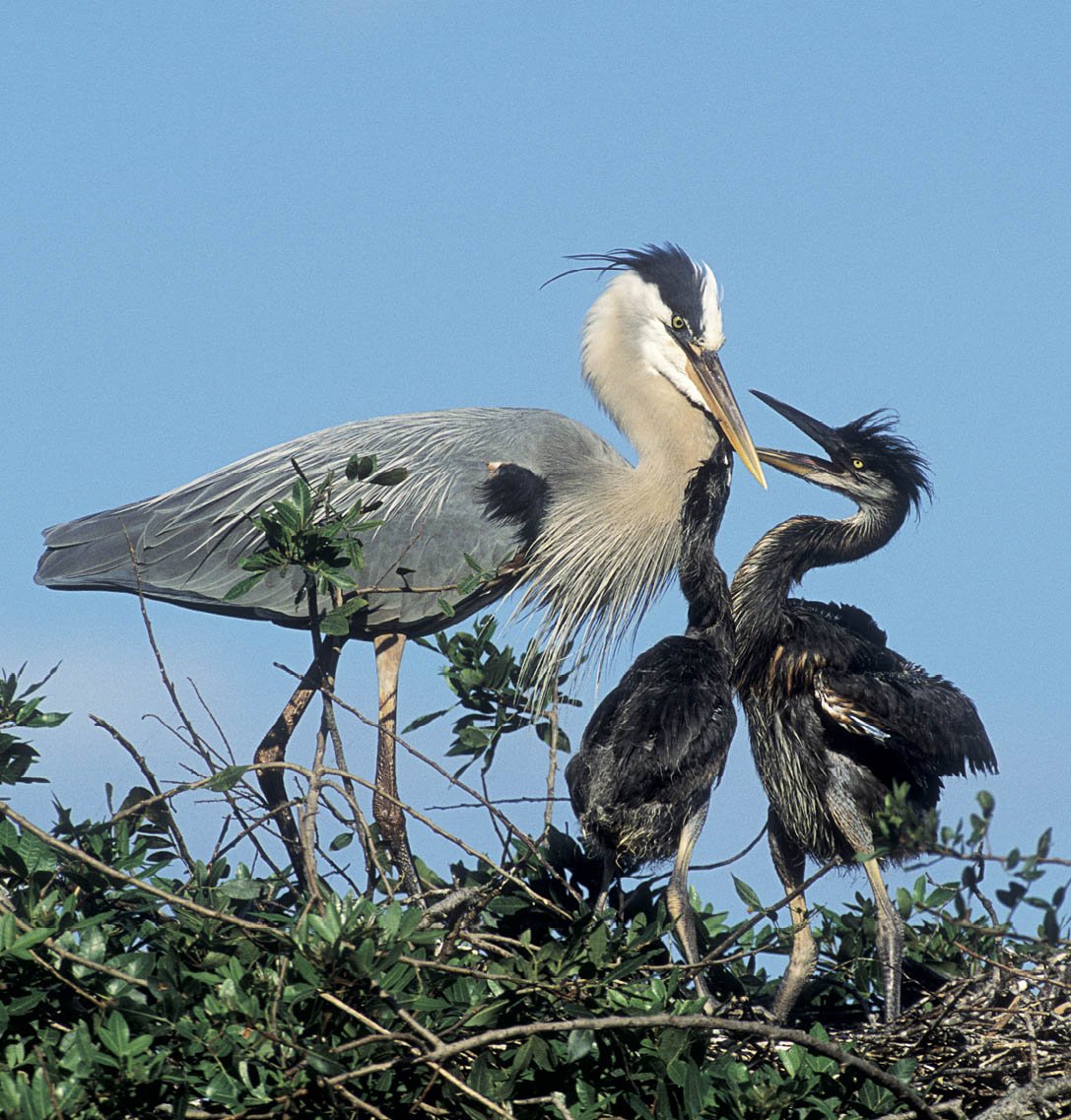
These half-grown Great Blue Heron nestlings tap their parent’s bill, which stimulates the adult to regurgitate its stomach contents. A large, fairly undigested fish may fill a chick’s stomach even as one end remains in its esophagus. This can immobilize the chick for many minutes as it digests the meal.
As the chicks grow larger and hungrier, the parents spend more time away. When a chick notices a parent returning, it clacks its beak, and soon the whole brood joins in. At hatching, the chicks’ legs remain bent, so they can’t venture to the edge of the nest. By the time they’re three weeks old, they start walking around, their strong feet grabbing tight to sticks so even when near the edge, they virtually never fall out. Adult herons seldom feed chicks away from the nest.
Heron chicks start flapping their wings when a month old, and in another month can fly fairly well, even on their maiden voyage. The youngest siblings may be much slower to fledge than their elders. The young return for extra meals for weeks, but eventually develop their own fishing skills and become independent.
Some adult herons return to the same nest or colony year after year. One male, identifiable because he’s missing one rear toe and one front claw, returned to his nest in Sapsucker Woods in upstate New York for five years; by the end of that season he’d successfully fledged 20 chicks. Studies of banded herons at colonies indicate that adults select new mates every year.
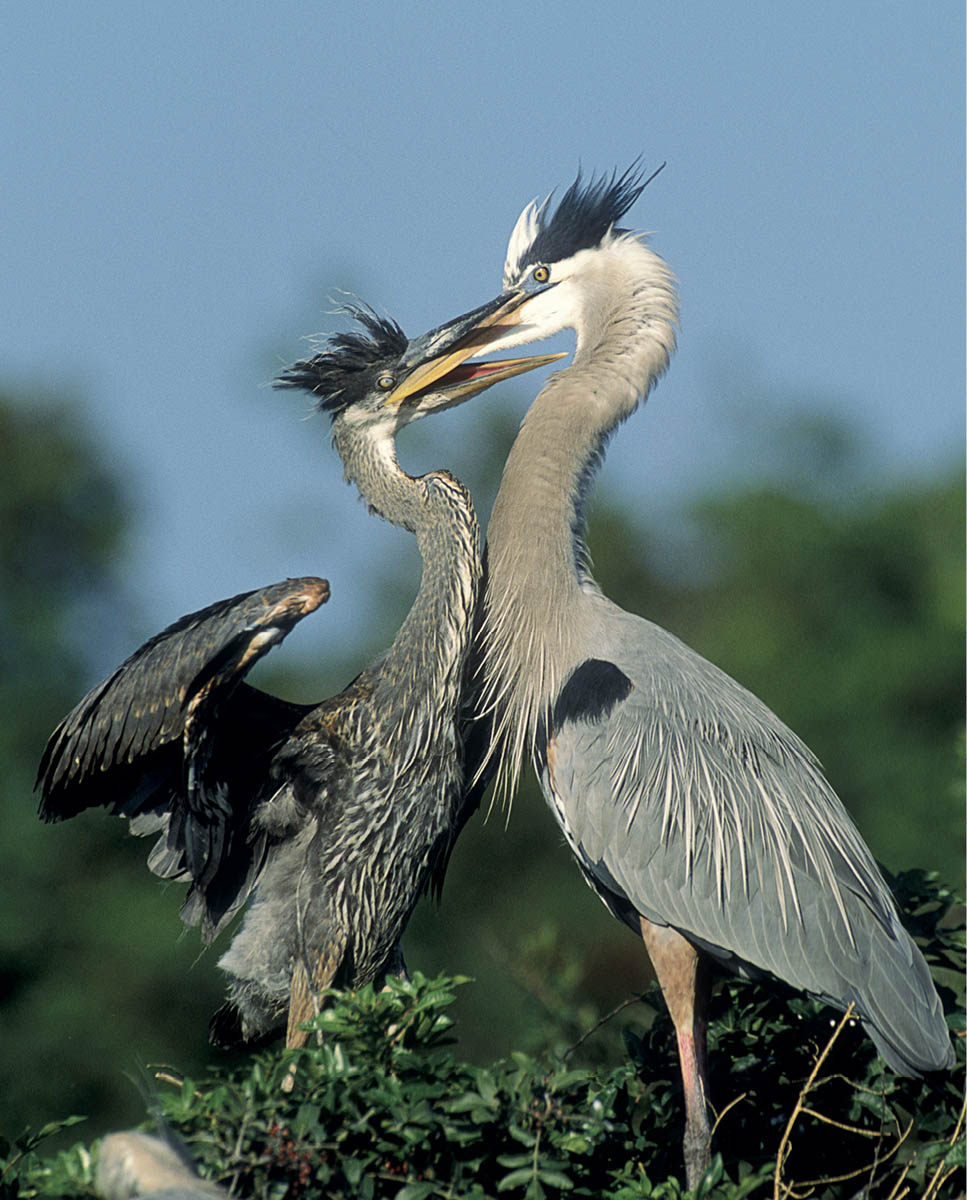
As heron chicks approach full size and grow more coordinated, they often start grabbing at food before the adult can even spit it out.
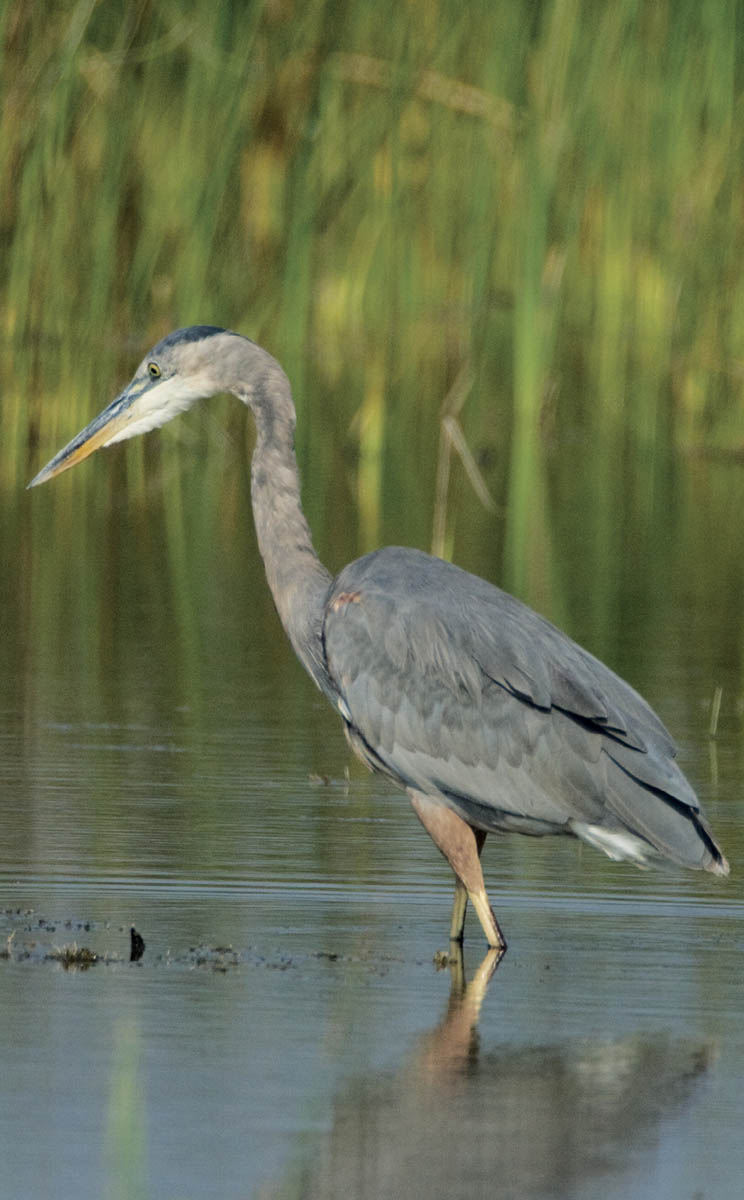
After Great Blue Herons fledge, it takes time for them to perfect their fishing skills. During the first two months after leaving the nest, they strike at prey about as often as adults do, but successfully capture prey only half as often. For weeks they can rely on supplemental meals from their parents at the nest.